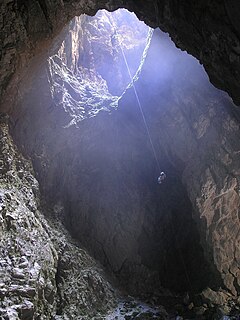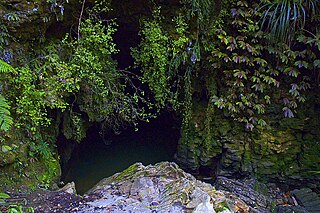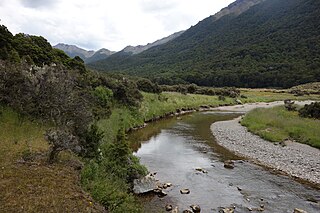
The Ngarua Caves are a series of limestone caves in the Takaka Hill range south of Abel Tasman National Park.

Limestone is a carbonate sedimentary rock that is often composed of the skeletal fragments of marine organisms such as coral, foraminifera, and molluscs. Its major materials are the minerals calcite and aragonite, which are different crystal forms of calcium carbonate (CaCO3). A closely related rock is dolomite, which contains a high percentage of the mineral dolomite, CaMg(CO3)2. In fact, in old USGS publications, dolomite was referred to as magnesian limestone, a term now reserved for magnesium-deficient dolomites or magnesium-rich limestones.

Takaka Hill is a range of hills located in the northwest of the South Island of New Zealand. Made of marble which has weathered into many strange forms and with numerous sink holes, it is typical karst country. The Marble is Ordovician in age and from the Takaka Terrane.

Abel Tasman National Park is a New Zealand national park located between Golden Bay and Tasman Bay at the north end of the South Island. It is named after Abel Tasman, who in 1642 became the first European explorer to sight New Zealand and who anchored nearby in Golden Bay.
Contents
The caves are located close to Takaka Hill's summit, adjacent to State Highway 60 as it winds its way over the Takaka Hill between Motueka and Upper Takaka. Scheduled tours suitable for people of all ages are provided by a commercial operator from the car park and cafe situated at the cave entrance. The caves cannot be visited unattended. [1]

State Highway 60 is a state highway servicing the far northwest of the South Island of New Zealand. Running between the settlements of Richmond and Collingwood, it is 116 kilometres (72 mi) long and lies entirely within the Tasman District. It is the northernmost highway in the South Island and is a popular tourist route, servicing Motueka, Abel Tasman National Park, Golden Bay, and Farewell Spit.

The town of Motueka in the South Island of New Zealand lies close to the mouth of the Motueka River, on the western shore of Tasman Bay. It is, after Richmond, the second largest centre in the Tasman Region, with a population of 7125. The Motueka Ward had an estimated population of 10,900 at 30 June 2009.
Ngarua Caves contain a variety of cave formations along a comfortable 300 metres (980 ft) walkway through the caves, as well as notable displays of Moa bones remaining in the caves. Ngarua Caves is listed as one of the "101 Must-Do's for Kiwis". [2]

Moa were nine species of now-extinct flightless birds endemic to New Zealand. The two largest species, Dinornis robustus and Dinornis novaezelandiae, reached about 3.6 m (12 ft) in height with neck outstretched, and weighed about 230 kg (510 lb). It is estimated that, when Polynesians settled New Zealand circa 1280, the moa population was about 58,000.











